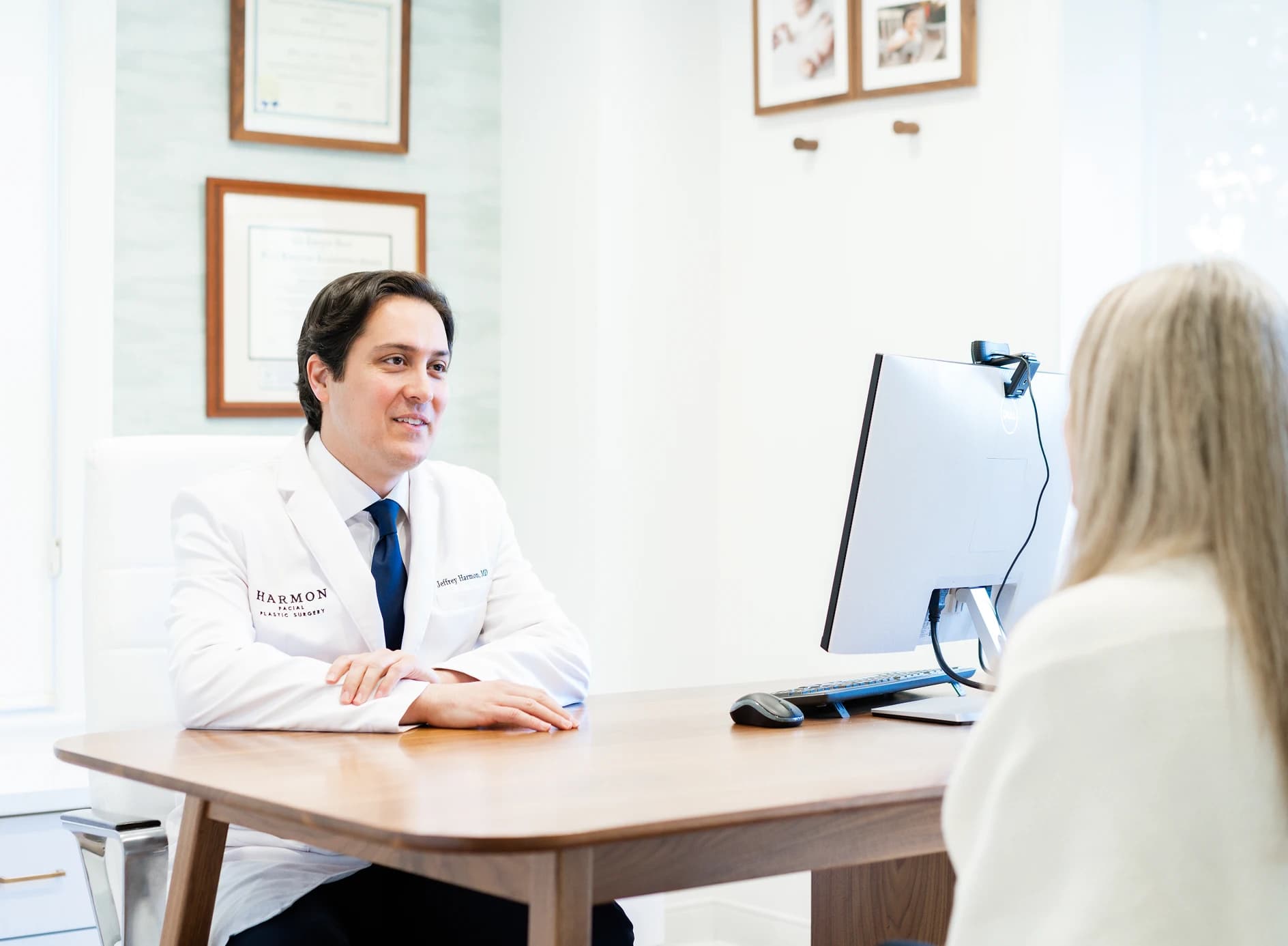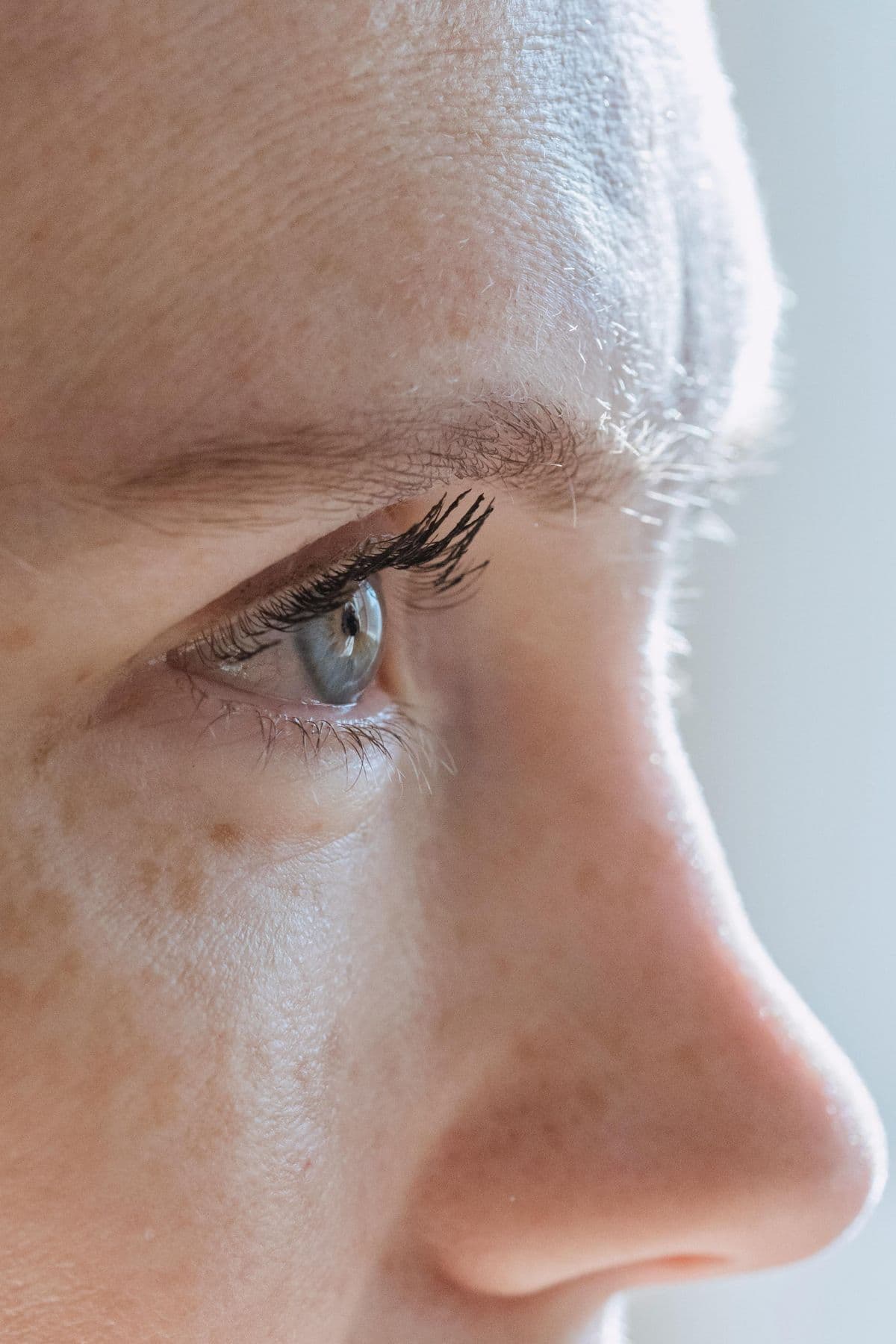Contact Us
What is Botox©?
Botox© is a Food and Drug Administration (FDA) approved medication derived from a naturally occurring substance and produced in a highly regulated environment. Botox© temporarily relaxes muscles in specific areas where the medication is injected. This medication is injected precisely into the muscles located in the forehead, between the eyebrows (glabella/eleven lines), and along the side of the eyes (crow’s feet) where strong contraction of these muscles can produce heavy folds visible on the skin. There are other areas of the face where Botox© can be placed that are considered FDA off-label. For example, Botox© is injected into the lower jawline in a muscle (masseter muscle) that can become tense and make the jawline appear wider than is preferred. The purpose of Botox© is to address aesthetic concerns about the face.
What Condition Does the Procedure Address?
Botox© addresses the effects of strong contraction of some facial muscles over time. These effects include deep folds in the skin evident when talking and expressing emotion, also known as dynamic wrinkles. This contrasts with static wrinkles, which are present when the face is at rest. Both dynamic and static wrinkles become more evident with age. Treatment with Botox© can improve the appearance of dynamic wrinkles while preserving an individual’s range of expression.
Dynamic wrinkles can make individuals appear older because they accentuate changes occurring at the skin surface, including static wrinkles. Many describe the appearance of these changes as “harsh.” They are frequently evident in the forehead, between the eyebrows, and on the sides of the eyes.
Why Choose Dr. Harmon
The desire for youthfulness is understandable. There is no area more important than the face. After all, the face cannot be hidden. It is how we present ourselves to the world. Dr. Harmon works with a refined eye and trained hands to develop a personalized treatment plan with you, utilizing advanced techniques in surgical and non-surgical care of the face, nose, eyes, neck and hair.
Fellowship trained facial plastic surgeons have a unique specialized skill set in performing surgical and non-surgical procedures on the face, nose, eyes, neck and hair. The pathway to becoming a facial plastic surgeon begins with five years of rigorous training in head and neck surgery. This training is focused on all aspects of surgery for the head and neck, in addition to aesthetic and reconstructive procedures.
A small pool of top performing graduates from head and neck surgery programs are then selected to complete sub-specialty training as a fellow in facial plastic and reconstructive surgery through the American Academy of Facial Plastic and Reconstructive Surgery (AAFPRS).
Dr. Harmon completed his fellowship in facial plastic surgery through the AAFPRS with the world-renowned facial plastic surgeon Dr. Andrew Jacono on Park Avenue in New York City. Dr. Jacono is world renowned for developing the extended deep plane facelift technique. Dr. Harmon is one of the few surgeons in the world, and the only surgeon in the Cincinnati area, fellowship trained in this technique by Dr. Jacono.
Quad A Accredited Surgery Suite
Harmon Facial Plastic Surgery is proud to have a Quad A accredited operating room and facility in our office. Our single-physician, single-specialty facility meets or exceeds the strict guidelines and high standards set forth by Quad A, demonstrating our strong commitment to patient safety and excellence in surgical care. We utilize the services of board-certified anesthesiology physicians only as well as our own personal clinical support staff to ensure the most comfortable, safest experience for our clients.
Overview of the Procedure
The team at Harmon Facial Plastic Surgery works tirelessly to prepare patients well for their procedure. The time spent with patients and resources provided facilitates a smooth transition from the procedure through recovery. The following overview is a broad summary of the information provided to patients:
Procedure Consultation
Expect a detailed, informative discussion with Dr. Harmon about your concerns and aesthetic goals. He will develop a personalized treatment plan to address these concerns and goals.
Pre-Treatment Preparation
There is no specific pre-treatment preparation necessary prior to treatment with Botox®. However, there may be some surgical or non-surgical treatments that could dictate the time frame in which Botox® can be administered. It is also ideal to avoid blood thinning medications such as nonsteroidal anti-inflammatory drugs (NSAIDs) such as ibuprofen for one week prior to treatment if possible.
Day of Treatment
It is ideal to arrive without makeup or other skin care products on the planned treatment sites. However, whether these products are in place or not, Dr. Harmon will clean the skin thoroughly prior to administering Botox® treatment.
Follow-Up Appointment
Dr. Harmon follows up with patients approximately two weeks after their first treatment with Botox®. He does this to confirm that the appropriate dosage has been administered. All follow-up appointments would be for re-administration of Botox® once the effects have worn off and as needed.
Social Readiness
Patients are advised against massaging their face or exercising for twenty-four hours after treatment. Most patients are socially ready by the following day.
Ideal Candidates for Botox©
Ideal candidates for Botox© are those who experience deep, coarse folds when speaking or expressing emotion (dynamic wrinkles) in the following areas:
- Forehead
- Between the Eyebrows, otherwise known as the glabella, frown lines, or eleven lines
- Side of the eyes, otherwise known as the crow’s feet
Most candidates for Botox© range in age from their twenties (20s) to seventies (70s). Consultation is essential to determine candidacy for the procedure because there may be factors that preclude this procedure for certain individuals. Reasonable expectations must be established about what Botox© can and cannot accomplish as with all cosmetic procedures.
What to Expect from Recovery
Recovery from Botox© treatment is specific to the individual but is generally minimal. The risk of swelling and bruising from injecting the medication is low.
If swelling does occur, it tends to resolve within twenty-four (24) hours. If bruising does occur, it tends to resolve within five (5) to seven (7) days.
The effects of Botox© usually start approximately three (3) to five (5) days after treatment. The maximal effect of treatment is usually reached by approximately fourteen (14) days after treatment.
The effects of Botox© gradually fade over a period of approximately three (3) to four (4) months for most individuals.
Swelling is resolved
Effects of Botox© start
Bruising tends to resolve
Maximal effect of treatment is reached
Effects of Botox© gradually fade
Benefits of Botox©
Botox© treats dynamic wrinkles, which contribute to facial aging. The benefits of Botox© include:
- Smoother appearance to the face when speaking or expressing emotion
- Relief of muscle tension at the site(s) of injection
Risks of Botox©
The risks of treatment with Botox© are low and primarily related to the use of small needles to administer the medication rather than the medication itself. Botox© has been administered millions of times with a high degree of safety. The potential risks of Botox© treatment include, but are not limited to:
- Swelling
- Bruising
- Allergic reaction
- Dispersion of the medication to other areas
Combine Botox© with Other Facial Enhancements
Botox© can treat dynamic wrinkles in a minimally-invasive manner, which other surgical and non-surgical treatments cannot. As a result, they are an excellent complement to other procedures including, but not limited to:
Deep plane facelift
A deep plane facelift helps restore youthful structure, while Botox© may soften dynamic lines. Together, they can enhance both form and expression for a naturally refreshed look.
Brow Lift
Botox© can extend and refine the results of a brow lift by maintaining a lifted, relaxed brow position and help prevent new creases from forming over time.
Blepharoplasty
While eyelid surgery may rejuvenate the eye area structurally, Botox© can target crow’s feet and frown lines to further enhance brightness and openness around the eyes.
Laser skin resurfacing
Laser resurfacing smooths skin texture and helps improve tone; Botox© may complement these results by relaxing wrinkle-causing muscles, creating an overall smoother and more radiant appearance.
Fillers
Fillers help restore volume and contour, while Botox© can refine expression lines. When used together, they may offer a balanced, non-surgical approach to facial rejuvenation with natural, harmonious results.

Book Your Consultation
Take the first step toward your aesthetic goals with a personalized consultation. Dr. Harmon will listen to your concerns, answer your questions, and guide you through your options. Schedule your consultation today and discover how expert care can make a difference.
Read More About
Guide to Botox©
This blog post is adapted from a presentation we have given for interested groups who wanted more information about the use of Botox© in Cincinnati....

Can Botox© and Similar Products Improve the Appearance of Scars?
The treatment of scars is complex and often requires multiple modalities of treatment, including lasers, chemical peels, topical medications,...

What Can Botox© Treatment of the Corner of the Jawline (Masseter Muscles) Achieve?
Patients have increasingly sought treatment of the corner of the jawline with products such as Botox© for cosmetic and functional purposes. The...
FAQ
Who administers Botox© at Harmon Facial Plastic Surgery?
Dr. Jeffrey Harmon administers all Botox© himself. Dr. Harmon has the detailed understanding of facial anatomy and the experience as a fellowship-trained facial plastic surgeon to provide the safest, most effective treatment.
Can Botox© treat all wrinkles anywhere in my face and neck?
No. Botox© can be used to reduce the appearance of dynamic wrinkles, or those wrinkles that become more prominent with movement of the facial musculature. More superficial, static wrinkles that exist at rest and are due to changes in the skin are best treated with laser resurfacing. Botox© can be used to treat dynamic wrinkles in the forehead, between the eyebrows (eleven lines) and on the sides of the eye (crow's feet). However, Dr. Harmon does not use it to treat wrinkles around the mouth (smoker's lines), under the eyes, or in the neck.
What areas of the face will Dr. Jeffrey Harmon NOT treat with Botox©?
Dr. Harmon will NOT treat the upper lip (i.e., lip flip) or the lower eyelids with Botox©. This is due to the risk of causing functional problems to the mouth and eyelids, respectively.
What is "traptox" and is it worthwhile?
"Traptox" is an abbreviation for the non-surgical procedure whereby Botox© or a similar product are injected into the trapezius muscles. The trapezius muscles are paired triangular-shaped muscles that extend across the back of the neck, shoulders, and back. They help control movement of the neck and shoulder blades. The term "traptox" has been widely circulated on social media. In fact, it is one of the most common locations to inject Botox© or a similar product in South Korea, where it was pioneered – see the blog for additional information on facial plastic surgery in South Korea. The purpose is to create the appearance of a longer neck. We at Harmon Facial Plastic Surgery do not recommend injecting Botox© or a similar product in this location. This is because the trapezius muscles are essential to maintaining stability of the neck and shoulders. Weakness of these muscles can lead to neck and shoulder pain. For example, patients with head and neck cancer sometimes require removal of the nerve that controls movement of this muscle. A non-functional trapezius muscle can lead to debilitating shoulder pain in such a case.
Is Botox© a common treatment?
Yes, Botox© is a common non-surgical treatment. The International Society of Aesthetic Plastic Surgery (ISAPS) release statistics each year that provide insight into the state of plastic surgery around the world. ISAPS reported botulinum toxin was administered 1,477,000 times in the United States in 2020.
What type of anesthesia is required?
Botox© administration is generally minimally painful and usually requires no anesthesia. Some individuals may require topical anesthesia, however.
How long does Botox© last?
Botox© generally lasts 3 to 4 months. However, there are rare instances where treatment can last less than 3 months or longer than 4 months.
Can regular treatment with Botox© prevent the formation of wrinkles?
While a reasonable idea, there is currently no clinical evidence that early treatment with Botox© prevents the formation of wrinkles.
Can men benefit from Botox©?
Absolutely, men can benefit from Botox© placed in the same locations as women. In fact, men tend to develop much stronger, coarser wrinkles with age. Botox© can be an excellent option to treat these wrinkles.
What areas of the face does Dr. Jeffrey Harmon treat with Botox©?
Dr. Harmon treats the forehead, glabella (i.e., eleven lines, frown lines), crow's feet, bunny lines, mentalis muscle (i.e., chin dimples), masseter muscles (i.e., jawline) and underarms (for excessive sweating) with Botox©. He performs all Botox© injections himself.
Can Treatment with Botox© Give Me a Brow Lift?
Yes, treatment with Botox© can lift the eyebrows beautifully, though not as effectively as a surgical brow lift. The effects are also temporary, lasting only as long as the medication lasts. The mechanism by which Botox© treatment results in a brow lift is counterintuitive. Unlike a surgical brow lift, in which the brows are lifted and secured from above, a brow lift using Botox© weakens the muscles below the eyebrows that pull the eyebrows down. There is a common misconception that treating the forehead with Botox© results in a non-surgical brow lift. In fact, treatment of the crow's feet and frown lines between the eyebrows results in a non-surgical brow lift, because muscles in these locations function as the brow depressors.
What is "jelly roll" Botox© and is it worthwhile?
"Jelly roll" Botox© refers to placing Botox© or similar medications in the lower eyelid in an area of a muscle, called the orbicularis oculi, that helps close the eye by lifting the lower eyelid. It is intended to reduce the bunching that can occur in some individuals with active muscle movement at this location. The term "jelly roll" Botox© has been used widely on social media. It is a treatment that is off-label for Botox© and other medications as defined by the Food and Drug Administration. We at Harmon Facial Plastic Surgery do not offer treatment of this location with Botox©, because weaking of the muscle at the lower eyelid can limit eyelid closure and temporarily change the shape of the lower eyelids. The potential problems associated with these changes include, but are not limited to, dry eyes and vision changes.
Written by Dr. Harmon
Discover the expertise and compassionate care of Dr. Jeff Harmon, a fellowship-trained facial plastic surgeon deeply rooted in the Cincinnati community. A former collegiate athlete and Cornell University graduate, Dr. Harmon brings discipline, precision, and a global perspective to his surgical practice—refined through elite fellowship training in New York City.
Located in Hyde Park, Harmon Facial Plastic Surgery proudly serves patients throughout the Cincinnati area offering personalized facial aesthetics with world-class skill and a hometown heart.